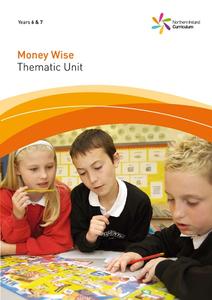Curated OER
Student Handout 6A :Trail of the Tomato Group A: Fast Food Chains /Grocery Stores
There is a lot to be learned from a tomato. Kids research the pressures that four major fast food and supermarket chains endure to keep customers coming back. They analyze how this pressure is then transferred to those working in the...
EngageNY
Random Sampling
Sample pennies to gain an understanding of their ages. The 16th installment of a 25-part series requires groups to collect samples from a jar of pennies. Pupils compare the distribution of their samples with the distribution of the...
Curated OER
Take Math Shopping!
Percents, estimation, and comparative analysis become more understandable when they are used in-context at the grocery store.
Curated OER
Consumerism - Grocery Shopping
Learners watch a video on how marketers plan their strategies in supermarkets. In groups, they are given a set amount of money and asked to go through a grocery store simulation with a list. After the simulation, they discuss the...
Curated OER
Consumer Education
Students, while examining an intense list of vocabulary terms on types of money, change and simple foods, name and state the cost of food items in supermarkets, grocery stores and flea markets with flash cards and newspaper ads.
Curated OER
What's the Price?
Fourth graders learn about price and comparative shopping. In this price and comparative shopping lesson plan, 4th graders read Amy Axelrod's, Pigs Go To Market: Fun with Math and Shopping. They use the book to investigate the meaning of...
Curated OER
Estimating School Store Purchases
Students examine uses for estimating, and round purchase prices to estimate total purchases in a simulated school store setting. They discuss what it means for an item to be on sale, and observe the teacher work through the process of...
Curated OER
Plan Grocery List & Field Trip To Store
Student write a list of groceries to purchase at the store given a certain amount of money. They check to make sure they have not spent more money than what they have. Then the students get with a partner and compare their two...
Council for Economic Education
Sand Art Brownies
Which is better, Coke or Pepsi? Pupils analyze the concept of substitute goods as they investigate the choice to purchase alternate products for better prices. Fun and practical, the engaging shopping exercise helps savvy scholars get...
Curated OER
"Grocery Store"
Students purchase grocery items from the classroom grocery store using appropriate play coins and bills. Students define various economic terms. Students comprehend the concept of a medium for exchange.
Curated OER
Grocery Shopping and Budgeting
Ninth graders establish a food budget based on individual needs and resources. They evaluate grocery stores and establish guidelines for purchasing specific foods.
Curated OER
Shopping the Sunday Circular
Pupils demonstrate an understanding of price-per-unit mathematics. In this computation lesson, learners accurately figure the unit price of grocery items. They create a chart and record the item, the price, the size and the cost per item.
Practical Money Skills
Shopping Wisely
Work on making good shopping choices with a fun economics project. Kids analyze the differences between brand names and generic products, bigger and smaller units for purchase, and different places they can shop for different items.
Curated OER
The Price Is Right - Grocery Store Prices
Eighth graders use the unit price to compare which local grocery store has the best prices. Assign students to work with a partner and a role. One person is the recorder and the other is the mathematician.
Curated OER
Third Grade Economics
In this economics learning exercise, 3rd graders answer questions about crops, natural resources, prices of items, and more. Students complete 20 multiple choice questions.
Curated OER
Grocery Shopping
Students apply budgeting and shopping strategies. They study consumer shopping skills and guidelines to be a better shopper by comparing stores, comparing prices and unit pricing, brands, using coupons and not being fooled with...
Northern Ireland Curriculum
Money Wise
Does money seem to slip through your middle schoolers' fingers? Encourage them to examine spending, saving, and budgeting habits with a unit on consumer skills and money management. Young spenders study the waste that occurs with school...
Illustrative Mathematics
Price per Pound and Pounds per Dollar
Help learners understand the concept of unit rate as it is applied to buying beans at a grocery store. The objective is to determine the unit rate in two ways, and then apply each ratio to an additional problem. The attached commentary...
Curated OER
Party Time
Students explore the cost of a party. In this math lesson, students plan a party and determine the cost of hosting a party. Students use information from grocery stores to determine the unit cost of items for the party.
Curated OER
Introducing the Concept: Rates
Sixth graders explore rates as a specific type of ratio, using visual examples of unit rates and unit prices to increase comprehension. They also practice solving problems that are modeled by the instructor. The well-scripted lesson is...
Curated OER
You'd Better Shop Around
Students compare and contrast the prices of various food items at different grocery stores using newspaper advertisements. Students discuss the benefits and drawbacks of shopping around for items that fit within their monthly budget.
Curated OER
Lesson 9: Tracking Commodities
Over the corse of a month, small groups will monitor the price of a specific energy commodity and analyze it in relation to global and domestic events. They play a trade simulation game and create infographics showing what they've...
Curated OER
Wants and Needs
Here is an outstanding activity on wants versus needs designed for 1st graders. Pupils listen to the book, Something Good which presents themes on wants, needs, choice, resources, and counting money. Pupils complete worksheets embedded...
Balanced Assessment
At the Supermarket
Grocery managers and chefs sure use lots of math. Scholars first use ratios and unit rates to determine a price for a can of corn. Once individuals have the pricing, they determine the amount of ingredients necessary to make brownies...

























